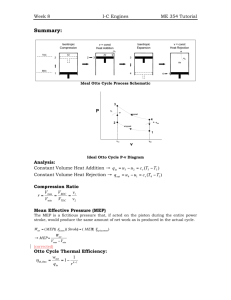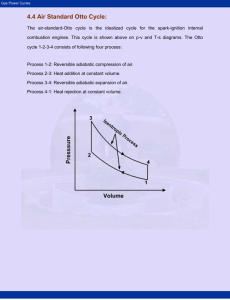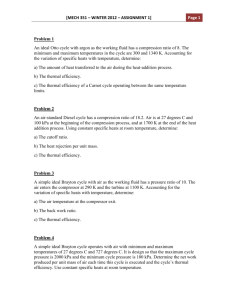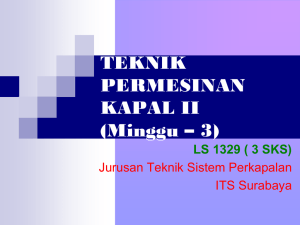Effects of Variable Specific Heat Ratio on Performance of an
advertisement
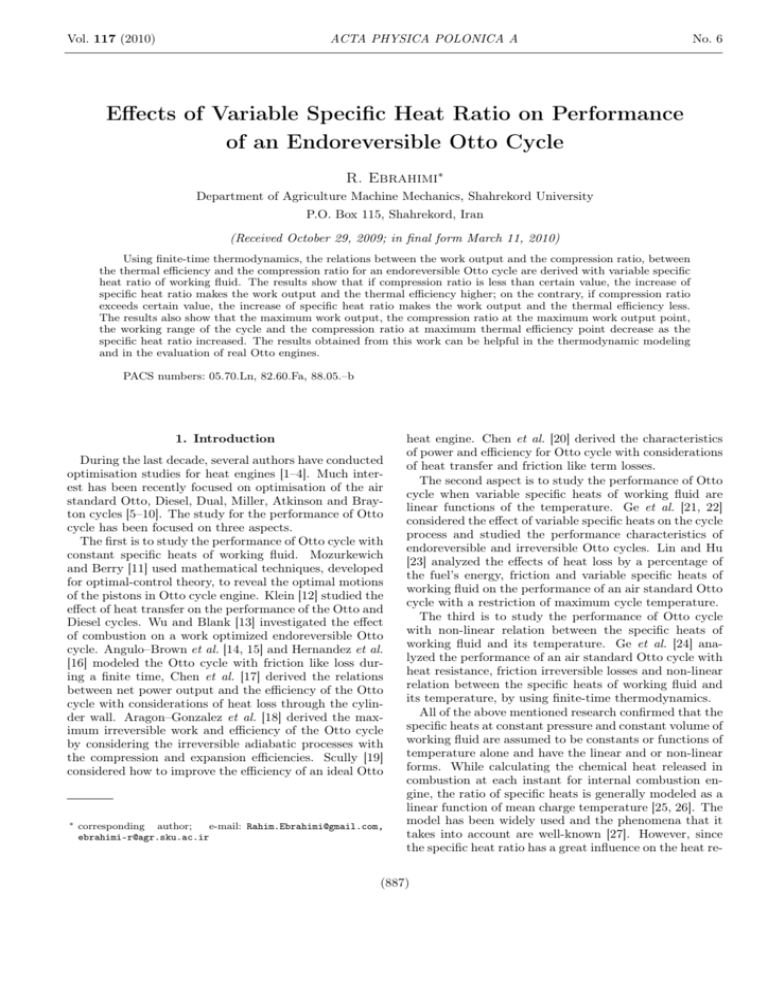
Vol. 117 (2010) ACTA PHYSICA POLONICA A No. 6 Effects of Variable Specific Heat Ratio on Performance of an Endoreversible Otto Cycle R. Ebrahimi∗ Department of Agriculture Machine Mechanics, Shahrekord University P.O. Box 115, Shahrekord, Iran (Received October 29, 2009; in final form March 11, 2010) Using finite-time thermodynamics, the relations between the work output and the compression ratio, between the thermal efficiency and the compression ratio for an endoreversible Otto cycle are derived with variable specific heat ratio of working fluid. The results show that if compression ratio is less than certain value, the increase of specific heat ratio makes the work output and the thermal efficiency higher; on the contrary, if compression ratio exceeds certain value, the increase of specific heat ratio makes the work output and the thermal efficiency less. The results also show that the maximum work output, the compression ratio at the maximum work output point, the working range of the cycle and the compression ratio at maximum thermal efficiency point decrease as the specific heat ratio increased. The results obtained from this work can be helpful in the thermodynamic modeling and in the evaluation of real Otto engines. PACS numbers: 05.70.Ln, 82.60.Fa, 88.05.–b 1. Introduction During the last decade, several authors have conducted optimisation studies for heat engines [1–4]. Much interest has been recently focused on optimisation of the air standard Otto, Diesel, Dual, Miller, Atkinson and Brayton cycles [5–10]. The study for the performance of Otto cycle has been focused on three aspects. The first is to study the performance of Otto cycle with constant specific heats of working fluid. Mozurkewich and Berry [11] used mathematical techniques, developed for optimal-control theory, to reveal the optimal motions of the pistons in Otto cycle engine. Klein [12] studied the effect of heat transfer on the performance of the Otto and Diesel cycles. Wu and Blank [13] investigated the effect of combustion on a work optimized endoreversible Otto cycle. Angulo–Brown et al. [14, 15] and Hernandez et al. [16] modeled the Otto cycle with friction like loss during a finite time, Chen et al. [17] derived the relations between net power output and the efficiency of the Otto cycle with considerations of heat loss through the cylinder wall. Aragon–Gonzalez et al. [18] derived the maximum irreversible work and efficiency of the Otto cycle by considering the irreversible adiabatic processes with the compression and expansion efficiencies. Scully [19] considered how to improve the efficiency of an ideal Otto ∗ corresponding author; e-mail: Rahim.Ebrahimi@gmail.com, ebrahimi-r@agr.sku.ac.ir heat engine. Chen et al. [20] derived the characteristics of power and efficiency for Otto cycle with considerations of heat transfer and friction like term losses. The second aspect is to study the performance of Otto cycle when variable specific heats of working fluid are linear functions of the temperature. Ge et al. [21, 22] considered the effect of variable specific heats on the cycle process and studied the performance characteristics of endoreversible and irreversible Otto cycles. Lin and Hu [23] analyzed the effects of heat loss by a percentage of the fuel’s energy, friction and variable specific heats of working fluid on the performance of an air standard Otto cycle with a restriction of maximum cycle temperature. The third is to study the performance of Otto cycle with non-linear relation between the specific heats of working fluid and its temperature. Ge et al. [24] analyzed the performance of an air standard Otto cycle with heat resistance, friction irreversible losses and non-linear relation between the specific heats of working fluid and its temperature, by using finite-time thermodynamics. All of the above mentioned research confirmed that the specific heats at constant pressure and constant volume of working fluid are assumed to be constants or functions of temperature alone and have the linear and or non-linear forms. While calculating the chemical heat released in combustion at each instant for internal combustion engine, the ratio of specific heats is generally modeled as a linear function of mean charge temperature [25, 26]. The model has been widely used and the phenomena that it takes into account are well-known [27]. However, since the specific heat ratio has a great influence on the heat re- (887) 888 R. Ebrahimi lease peak and on the shape of the heat release curve [28], many researchers have elaborated different mathematical equations to describe the dependence of specific heat ratio on temperature [25, 27–29]. It should be noted that the most important thermodynamic property used in the heat release calculations for engines is the specific heat ratio [29]. Therefore, the objective of this paper is to examine the effect of variable specific heat ratio on the power output and the thermal efficiency of an air standard Otto cycle. relation [24, 31] Qht = mt B (T2 + T3 ) , (3) where mt is the mass of air-fuel mixture inducted into the cylinder per cycle and B is constant. Since the total energy of the delivered fuel Qfuel is assumed to be the sum of the heat added to the working fluid Qin and the heat leakage Qht , 2. Thermodynamic analysis The relations between ma (the mass of air inducted into the cylinder per cycle) and mf , as well as between Ma and mt are defined as [30]: ma φ , (5) mf = (ma /mf )s and µ ¶ φ mt = ma 1 + , (6) (ma /mf )s where φ is the equivalence ratio, ma /mf is the air-fuel ratio and the subscript s denotes stoichiometric conditions. Substitution from Eqs. (5) and (6) into Eq. (4) gives ma Qin = Qfuel − Qht = (ma /mf )s h i £ ¤ × ηcom φQLHV − B (ma /mf )s + φ (T2 + T3 ) . (7) An air-standard Otto cycle model is shown in Fig. 1. Process 1 → 2s is a reversible adiabatic compression, while process 1 → 2 is an irreversible adiabatic process that takes into account the internal irreversibility in the real compression process. The heat addition is an isochoric process 2 → 3. Process 3 → 4s is a reversible adiabatic expansion, while 3 → 4 is an irreversible adiabatic process that takes into account the internal irreversibility in the real expansion process. The heat rejection is an isochoric process 4 → 1. Fig. 1. Temperature-entropy diagram for an air standard Otto cycle. As already mentioned in the previous section, it can be supposed that the specific heat ratio of the working fluid is a function of temperature alone and has the linear forms: γ = γ◦ − k1 T. (1) where γ is the specific heat ratio and T is the absolute temperature; γ◦ and k1 are constants. The total value of the heat that can be released from the combustion of the quantity mf of fuel (Qfuel ) and is controlled by the combustion efficiency, ηcom , of the fuel in question [30]: Qfuel = ηcom mf QLHV , (2) where QLHV is the lower heating value of the fuel. It is assumed that the heat loss through the cylinder wall is proportional to the average temperature of the working fluid and the cylinder wall and that during the operation the wall temperature remains approximately constant. The heat leak is given by the following linear Qin = Qfuel − Qht = ηcom mf QLHV − mt B (T2 + T3 ) . (4) Also the heat added to the working fluid during process (2 → 3), with using Eq. (6) is ¶ Z T3 Z T3 µ Rair Qin = mt cv dT = mt dT γ◦ − k 1 T − 1 T2 T2 µ ¶ µ ¶ ma Rair φ γ◦ − k 1 T 2 − 1 = 1+ ln ,(8) k1 (ma /mf )s γ◦ − k 1 T 3 − 1 where cv is the specific heat at constant volume and Rair is the gas constant of the working fluid. The heat rejected by the working fluid, during the process (4 → 1), with using Eq. (6) is ¶ Z T4 Z T4 µ Rair Qout = mt cv dT = mt dT γ◦ − k1 T − 1 T1 T1 µ ¶ µ ¶ ma Rair φ γ◦ − k 1 T 1 − 1 = 1+ ln .(9) k1 (ma /mf )s γ◦ − k 1 T 4 − 1 Because cp and cp are dependent on temperature, the adiabatic exponent γ = cp /cv will vary with temperature as well. Therefore, the equation often used in reversible adiabatic process with constant γ cannot be used for reversible adiabatic process with variable γ. However, according to [32, 33] a suitable engineering approximation to the reversible adiabatic process with variable γ can be made, i.e. this process can be divided into infinitesimal processes, for all of which the adiabatic exponent γ can be regarded as constant. For example, any reversible adiabatic process between states i and j can be regarded as consisting of numerous infinitesimal processes, for each of which a slightly different value of γ applies. For any Effects of Variable Specific Heat Ratio . . . 889 of these processes, when an infinitesimal change of dT in temperature and change of dV in volume of the working fluid takes place, the equation for a reversible adiabatic process with variable γ can be written as follows: T V γ−1 = (T + dT )(V + dV )γ−1 . (10) From Eq. (11), one gets µ ¶γ◦ −1 Vj = Ti (γ◦ − k1 Tj − 1). (11) Tj (γ◦ − k1 Ti − 1) Vi The compression ratio is defined as V1 rc = . (12) V2 Therefore, the equations for processes (1 → 2s) and (3 → 4s) are respectively as follows: T1 (γ◦ − k1 T2s − 1)(rc )γ◦ −1 = T2s (γ◦ − k1 T1 − 1),(13) T3 (γ◦ − k1 T4s − 1) = T4s (γ◦ − k1 T3 − 1)(rc )γ◦ −1 .(14) For the two reversible adiabatic processes 1 → 2 and 3 → 4, the compression and expansion efficiencies can be defined as [31, 34]: ηc = (T2s − T1 )/(T2 − T1 ), (15) and ηe = (T4 − T3 )/(T4s − T3 ). (16) Using Eqs. (8) and (9), one can derive the expressions of the work output and efficiency as: µ ¶ ma Rair φ Wout = Qin − Qout = 1+ k1 (ma /mf )s µ ¶ (γ◦ − k1 T2 − 1)(γ◦ − k1 T4 − 1) × ln , (17) (γ◦ − k1 T3 − 1)(γ◦ − k1 T1 − 1) and ³ ´ ηth ln Wout = = Qin (γ◦ −k1 T3 −1)(γ◦ −k1 T1 −1) (γ◦ −k1 T2 −1)(γ◦ −k1 T4 −1) ³ ln γ◦ −k1 T4 −1 γ◦ −k1 T1 −1 ´ . Fig. 2. Effect of γ◦ on the variation of the work output with compression ratio (k1 = 0.00006). (18) When rc , ηc , ηe and T1 are given, T2s can be obtained from Eq. (13). Then, substituting T2s into Eq. (15) yields T2 . T3 can be deduced by substituting Eq. (7) into Eq. (8). T4s can be found from Eq. (14), and T4 can be deduced by substituting T4s into Eq. (16). By substituting T1 , T2 , T3 and T4 into Eqs. (17) and (18), respectively, the power output and thermal efficiency of the Otto cycle engine can be obtained. Therefore, the relations between the power output, the thermal efficiency and the compression ratio can be derived. Fig. 3. Effect of k1 on the variation of the work output with compression ratio (γ◦ = 1.4). 3. Numerical examples and discussion The following constants and ranges of parameters are used in the calculations: ηe = 0.97, ηc = 0.97, ma = 5.84 × 10−4 kg, k1 = 0.00003 → 0.00009 K−1 , γ = 1.31 → 1.41, B = 1.11 kJ/kg K, Qhv = 44000 kJ/kg, T1 = 350 K, ηc = 100%, rc = 1 → 100, (ma /mf )s = 14.6 and φ = 1 [20–23, 30, 35]. Using the above constants and range of parameters, the characteristics of Wout − rc and ηth − rc can be plotted. Figures 2–5 show the effects of the temperature-dependent specific heat ratio of the working fluid on Fig. 4. Effect of γ◦ on the variation of the thermal efficiency with compression ratio (k1 = 0.00006). 890 R. Ebrahimi Fig. 5. Effect of k1 on the variation of the thermal efficiency with compression ratio (γ◦ = 1.4). the work output and the thermal efficiency of the cycle. From these figures, it can be found that γ◦ and k1 play an important role on the work output and the thermal efficiency. It can be seen that the work output versus the compression ratio characteristic and the thermal efficiency versus the compression ratio characteristic are parabolic-like curves. In other words, the work output and the thermal efficiency increase with increasing compression ratio, reach their maximum values and then decrease with further increase in compression ratio. It should be noted that the heat added and the heat rejected by the working fluid decreases with increasing of γ◦ , while increases with increasing k1 (see Eqs. (8) and (9)). It can be seen that the effect of γ◦ is stronger than that of k1 on the net work output and thermal efficiency. It is also clearly seen that the effects of γ◦ and k1 on the work output and thermal efficiency are related to compression ratio. They reflect the performance characteristics of an endoreversible Otto cycle engine. The effects of γ◦ and k1 on the power output are shown in Figs. 2 and 3. One can see that when γ◦ (k1 ) increases, the maximum work output, the compression ratio at the maximum work output point and the working range of the cycle decrease (increase). This is due to the fact that the ratio of heat added to heat rejected increases (decreases) with increasing γ◦ (k1 ). For this case, when γ◦ (k1 ) increases 7.6% (200%), the maximum power output, the compression ratio at maximum power output and the working range of the cycle decrease by about 11.3% (2%), 20.6% (2%), and 36% (2%) respectively. The results also show that if compression ratio is less than certain value, the increase (decrease) of γ◦ (k1 ) will make the power output bigger, due to the increase in the ratio of the heat added to the heat rejected. In contrast, if compression ratio exceeds certain value, the increase (decrease) of γ◦ (k1 ) will make the power output smaller, because of the decrease in the ratio of the heat added to the heat rejected. It should be mentioned here that for a fixed k1 , a larger γ◦ corresponds to a greater value of the specific heat ratio and for a given γ◦ , a larger k1 corresponds to a lower value of the specific heat ratio. Figures 4 and 5 reflect the effects of γ◦ and k1 on the thermal efficiency of the cycle with respect to the compression ratio. With the increasing γ◦ (k1 ), the maximum thermal efficiency increases (decreases) while the compression ratio at maximum thermal efficiency point decreases (increases). In this case, when γ◦ (k1 ) increases by about 7.6% (200%), the maximum thermal efficiency increases (decreases) by 62% (2%) and the compression ratio at maximum thermal efficiency decreases (increases) by about 18.2% (2%). The results also show that if rc is less than certain value, the increase (decrease) of γ◦ (k1 ) will make the thermal efficiency higher; on the contrary, if rc exceeds certain value, the increase (decrease) of γ◦ (k1 ) will make the thermal efficiency less. According to the above analysis, it can be found that the effects of the temperature-dependent specific heat of the working fluid on the cycle performance are obvious, and they should be considered in practice cycle analysis to make the cycle model more close to practice. 4. Conclusions The finite-time thermodynamic model of a realistic internal combustion engine cycle is a powerful tool for understanding and optimizing the performance of Otto cycles. The relations between work output, thermal efficiency, compression ratio and the specific heat ratio are derived. The detail effect analyses are shown by numerical calculation. The results show that there are optimal values of the compression ratio at which the work output and efficiency attain their maxima. It is also found that if compression ratio is less than certain value, the increase of specific heat ratio makes the work output and the thermal efficiency higher; on the contrary, if compression ratio exceeds certain value, the increase of specific heat ratio makes the work output and the thermal efficiency less. However, the effects of the temperature-dependent specific heat ratio of the working fluid on the endoreversible cycle performance are significant, and should be considered in practical cycle analysis and design. The results can provide significant guidance for the performance evaluation and improvement of real Otto engines. References [1] L. Chen, F. Zeng, F. Sun, C. Wu, Energy 21, 1201 (1996). [2] P.L. Curto-Risso, A. Medina, A. Calvo Hernadez, J. Appl. Phys. 105, 094904 (2009). [3] R. Ebrahimi, Journal of American Science 5, 83 (2009). [4] L. Chen, S. Xia, F. Sun, Energy Fuels 24, 295 (2010). [5] P.L. Curto-Risso, A. Medina, A. Calvo Hernadez, J. Appl. Phys. 104, 094911 (2008). [6] Y. Ge, L. Chen, F. Sun, C. Wu, J. Energy Institute 80, 105 (2007). Effects of Variable Specific Heat Ratio . . . [7] Y. Ge, L. Chen, F. Sun, Math. Comp. Model 50, 618 (2009). [8] Y. Ge, L. Chen, F. Sun, C. Wu, Int. J. Ambient Energy 26, 203 (2005). [9] Y. Ge, L. Chen, F. Sun, C. Wu, J. Energy Institute 80, 52 (2007). [10] Y. Ge, L. Chen, F. Sun, C. Wu, Int. J. ambient Energy 29, 65 (2008). [11] M. Mozurkewich, R.S. Berry, J. Appl. Phys. 53, 34 (1982). [12] S.A. Klein, Trans. ASME J. Engrg. Gas Turbine Pow. 113, 511 (1991). [13] D.A. Blank, C. Wu, Energy Convers. Mgmt 34, 493 (1993). [14] F. Angulo-Brown, J. Fernandez-Betanzos, C.A. Diaz-Pico, Eur. J. Phys. 15, 38 (1994). [15] F. Angulo-Brown, J.A. Rocha-Martinez, T.D. Navarrete-Gonzalez, J. Phys. D, Appl. Phys. 29, 80 (1996). [16] A.C. Hernandez, J.M.M. Roco, A. Medina, S. Velasco, Eur. J. Phys. 17, 11 (1996). [17] L. Chen, C. Wu, F. Sun, S. Cao, Energy Convers. Mgmt 39, 643 (1998). [18] G. Aragon-Gonzalez, A. Canales-Palma, A. Leon-Galicia, J. Phys. D 33, 1403 (2000). [19] M.O. Scully, Phys. Rev. Lett. 88, 050602 (2002). [20] L. Chen, T. Zheng, F. Sun, C. Wu, Int. J. Ambient Energy 24, 195 (2003). [21] Y. Ge, L. Chen, F. Sun, C. Wu, Int. J. Therm. Sci. 44, 506 (2005). [22] Y. Ge, L. Chen, F. Sun, C. Wu, Int. J. Exergy 2, 274 (2005). 891 [23] J. Lin, S. Hou, Energy Convers. Mgmt 49, 1218 (2008). [24] Y. Ge, L. Chen, F. Sun, Appl. Energy 85, 618 (2008). [25] J.A. Gatowski, E.N. Balles, K.M. Chun, F. Nelson, J.A. Ekchian, F.B. Heywood, A heat release analysis of engine pressure data. SAE Paper No, 841359 (1984). [26] R. Ebrahimi, Experimental study on the auto ignition in HCCI engine, Ph.D. Thesis, Valenciennes et du Hainaut-Cambrésis, France, (2006) (in French). [27] M. Klein, A Specific Heat Ratio Model and Compression Ratio Estimation, Department of Electrical Engineering, Ph.D. Thesis, Linköping University, Sweden (2004). [28] R. Lanzafame, M. Messina, ICE gross heat release strongly influenced by specific heat ratio values. Int. J. Automotive Technol. 4, 125 (2003). [29] M.A. Ceviz, I. Kaymaz, Energy Convers. Mgmt 46, 2387 (2005). [30] J.B. Heywood, Internal combustion engine fundamentals, New York McGraw Hill (1988). [31] L. Chen, Y. Ge, F. Sun, J. Automobile Engineering 222, 1489 (2008). [32] Y. Ge, L. Chen, F. Sun, C. Wu, Int. J. Ambient Energy, 29, 127 (2008). [33] Y. Ge, L. Chen, F. Sun, C. Wu, Appl. Energy 83, 1210 (2006). [34] Y. Ge, L. Chen, F. Sun, J. Automobile Engineering 222, 887 (2008). [35] R. Ebrahimi, J. Energy Institute 83, 1 (2010).
